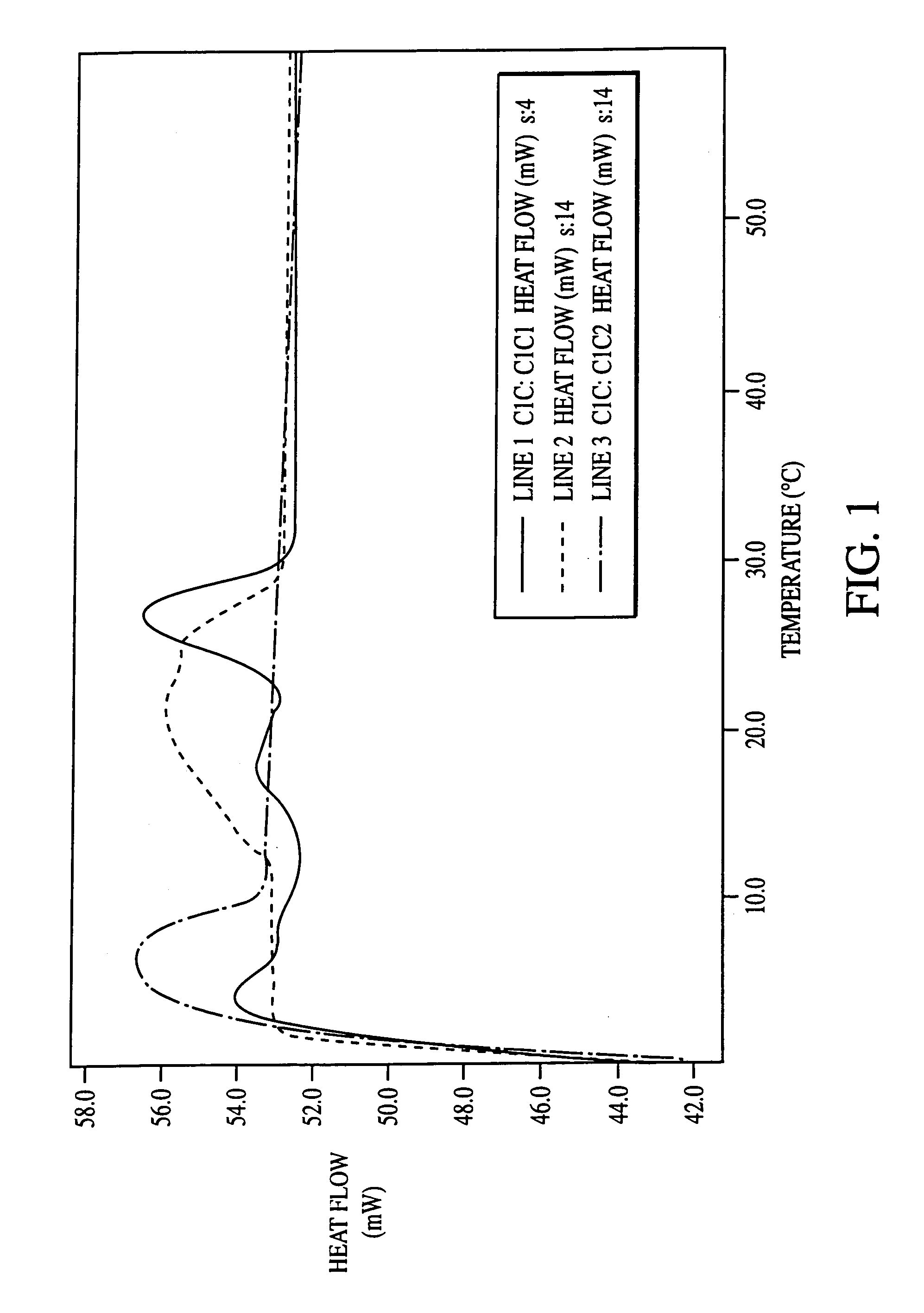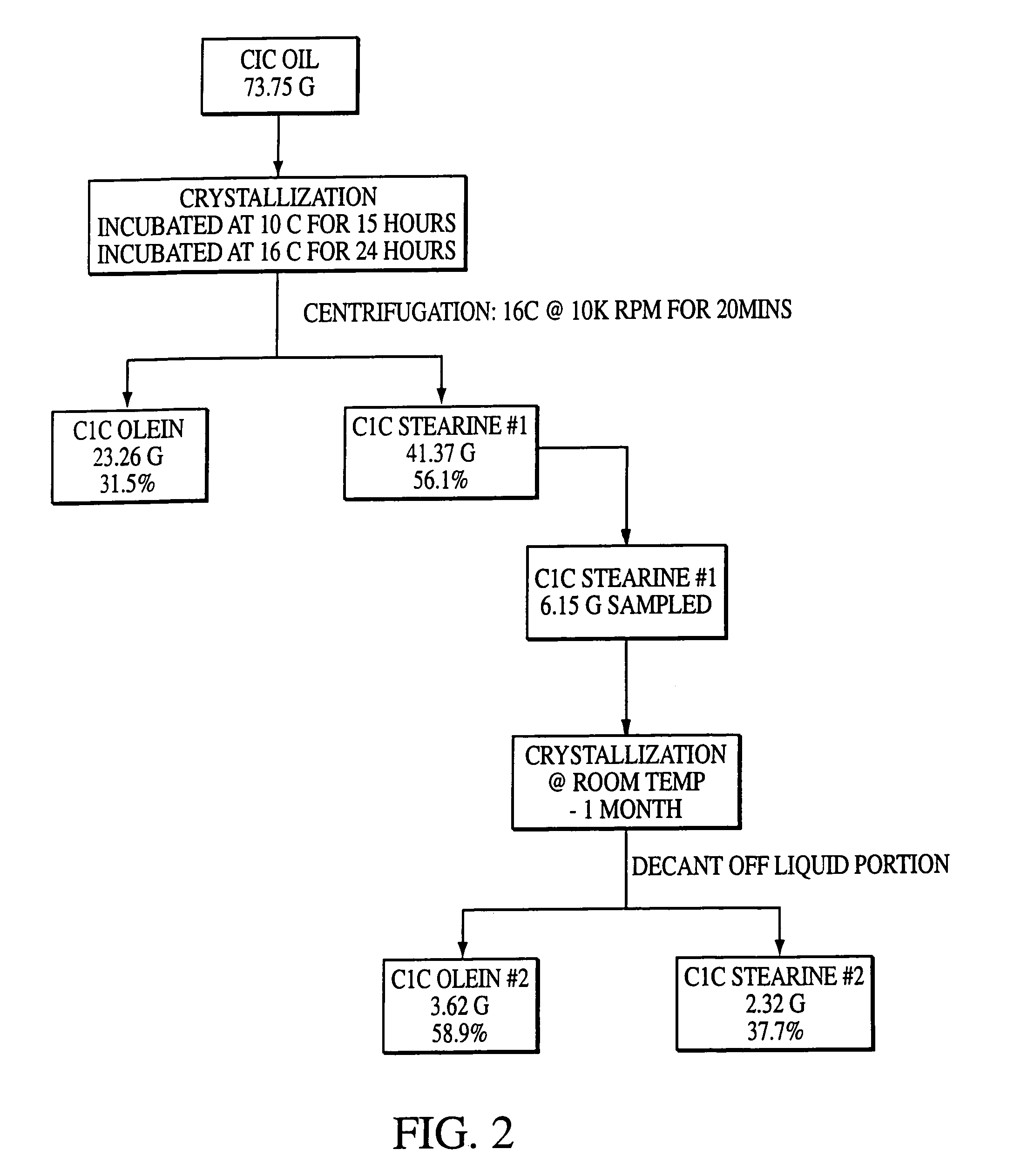Vegetable oil having elevated stearic acid content
a technology of stearic acid and vegetable oil, applied in the field of vegetable oil, can solve the problems of high cost of cocoa butter and failure to create other cocoa butter equivalents from oilseed plants
- Summary
- Abstract
- Description
- Claims
- Application Information
AI Technical Summary
Benefits of technology
Problems solved by technology
Method used
Image
Examples
example 1
[0057]Creation of Plant Line C1C Having Elevated Stearic Acid and Reduced Polyunsaturates. This example describes the creation of a Brassica napus plant line that yields seeds having an increased stearic acid content and a decreased polyunsaturate content. The alteration in fatty acid composition results from the introduction of three different transgenes and two chemically-induced mutant genes into a single line. The first transgene contains an oleoyl-ACP thioesterase coding sequence that confers an increased stearic acid content when overexpressed in a transgenic plant. The second transgene contains a delta-9 fatty acid desaturase coding sequence that inhibits delta-9 desaturase activity by cosuppression. The third transgene contains a delta-12 fatty acid desaturase coding sequence that inhibits delta-12 desaturase activity by antisense. One of the mutations in the plant line is in a fad2 gene, which encodes a delta-12 fatty acid desaturase. The second mutation presumably resides ...
example 2
[0064]Creation of Plant Line LHS015-08 Having Elevated Stearic Acid and Reduced Polyunsaturates. This example describes the creation of a Brassica napus plant line that yields seeds having an increased stearic acid content and a decreased polyunsaturate content. The 241-173×158-8-IMC130 line of Example 1, which carries mutations and transgenes causing overexpression of oleoyl-ACP desaturase and inhibition of delta-9 and delta-12 desaturases, was used in combination with genetic modifications as described below.
[0065]A transformation was carried out in which a B. napus delta-15 fatty acid desaturase gene, driven by a napin promoter and linked to a napin polyA terminator element, was introduced into a canola-type Brassica napus variety by Agrobacterium-mediated transformation as described above. Transgenic plants were identified in which the delta-15 desaturase gene was stably inherited by Southern analysis and in which desaturase activity was suppressed, based on the decrease in α-li...
example 3
[0068]Extraction and Analysis of CIC Oil To extract oil, seeds produced by the plants of the invention were cooked and screw pressed. The cakes that are expelled from the screw press then were solvent extracted using a 4″ heat traced column.
[0069]The following cooking procedure was employed to extract oil from seeds of the C1C line of Example 1. Seeds of the C1C line were placed in a large steel can containing steam coils (the inner diameter of the can was approximately 12″), and steam was passed through the coils to raise the temperature of the seed. The seeds were cooked at 70° C. for 30 minutes and then broken open with a screw press. While the majority of the oil within the seeds was released by passing them through a screw press, the pressed seed cake contains some residual oil. The initial seed moisture for the C1C variety was 4.5 wt %, and the final seed moisture was 2.7 wt % (no water was added prior to cooking).
[0070]The cakes expelled from the screw press were solvent extr...
PUM
| Property | Measurement | Unit |
|---|---|---|
| DSC melting point | aaaaa | aaaaa |
| DSC melting point | aaaaa | aaaaa |
| DSC melting point | aaaaa | aaaaa |
Abstract
Description
Claims
Application Information
 Login to View More
Login to View More - R&D
- Intellectual Property
- Life Sciences
- Materials
- Tech Scout
- Unparalleled Data Quality
- Higher Quality Content
- 60% Fewer Hallucinations
Browse by: Latest US Patents, China's latest patents, Technical Efficacy Thesaurus, Application Domain, Technology Topic, Popular Technical Reports.
© 2025 PatSnap. All rights reserved.Legal|Privacy policy|Modern Slavery Act Transparency Statement|Sitemap|About US| Contact US: help@patsnap.com


